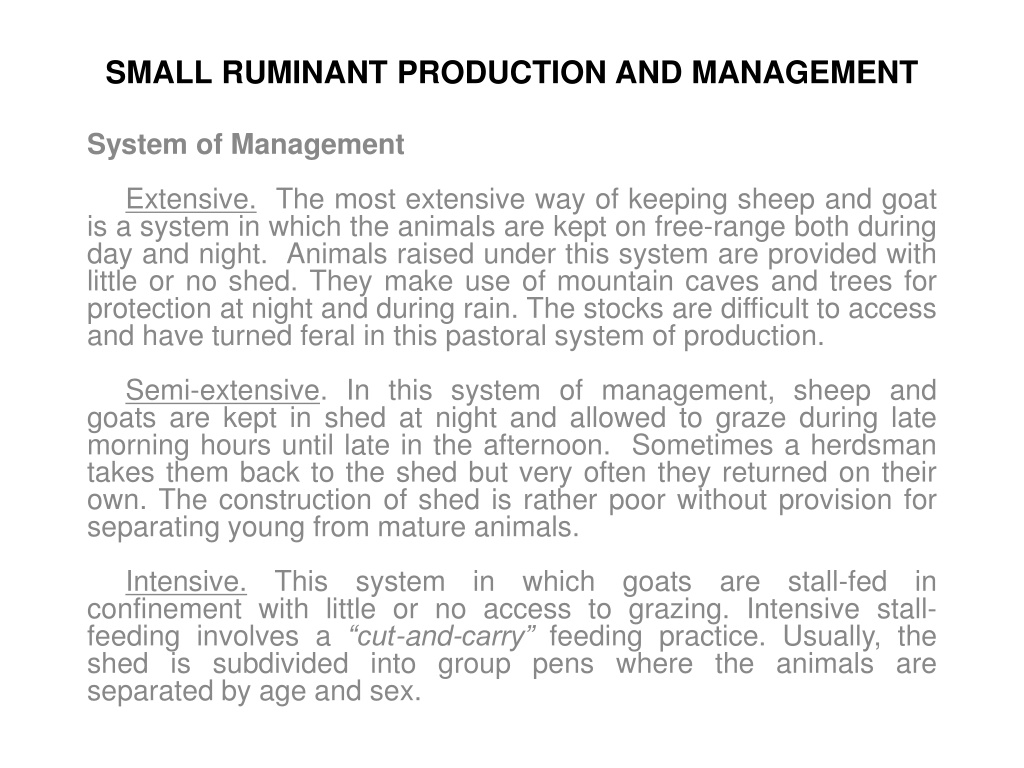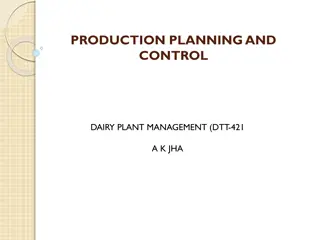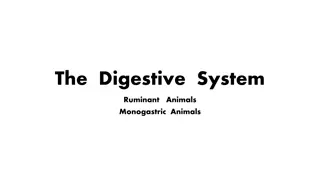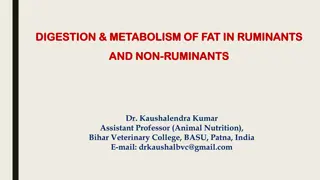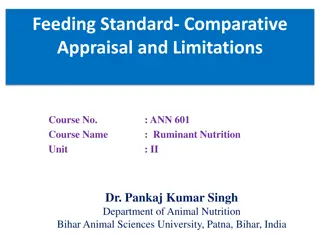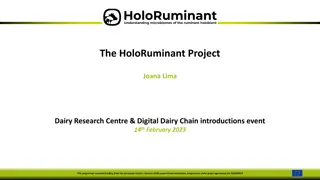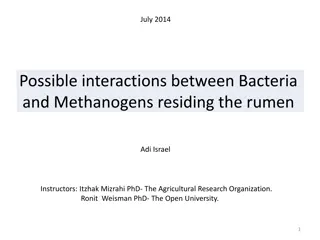Small Ruminant Production and Management Systems
System of Management in Small Ruminant Production includes extensive, semi-extensive, intensive, tethering, and integration with crops. Technical terms in small ruminant farming such as abortion, afterbirth, anemia are explained. The different systems of management and technical terms are important for successful small ruminant production.
Download Presentation

Please find below an Image/Link to download the presentation.
The content on the website is provided AS IS for your information and personal use only. It may not be sold, licensed, or shared on other websites without obtaining consent from the author. Download presentation by click this link. If you encounter any issues during the download, it is possible that the publisher has removed the file from their server.
E N D
Presentation Transcript
SMALL RUMINANT PRODUCTION AND MANAGEMENT System of Management Extensive. The most extensive way of keeping sheep and goat is a system in which the animals are kept on free-range both during day and night. Animals raised under this system are provided with little or no shed. They make use of mountain caves and trees for protection at night and during rain. The stocks are difficult to access and have turned feral in this pastoral system of production. Semi-extensive. In this system of management, sheep and goats are kept in shed at night and allowed to graze during late morning hours until late in the afternoon. Sometimes a herdsman takes them back to the shed but very often they returned on their own. The construction of shed is rather poor without provision for separating young from mature animals. Intensive. confinement with little or no access to grazing. Intensive stall- feeding involves a cut-and-carry feeding practice. Usually, the shed is subdivided into group pens where the animals are separated by age and sex. This system in which goats are stall-fed in
Tethering. By tethering, an animal is tied with a rope and staked to the ground to graze. Only adults are tethered while young animals until weaned are kept loose. Shifting the peg or choosing a different tree or post to secure the tether provides free access to a fresh grazing area. Animals tethered in sparse grasslands have to be transferred to different sites. When they are brought home to the shed for the night, the tethering rope may be removed or shortened to avoid strangling the animal. Integration with Crops. This system includes either intensive management in which crop by-products can be stall-fed, or grazing under plantation crops in which the animals browse or graze on the under growth of rubber, coconut, or fruit trees.
Technical Terms Abortion. It is the giving birth to young at premature age. Afterbirth. It refers to the placenta and the other membranes expelled or sent out after the delivery of the fetus or young. All-wool. It is a fabric of any description in which yarns are 100% wool from the sheep. Anemia. It refers to a condition in which the red blood corpuscles are reduced in number or are deficient in hemoglobin. Antibiotic. t is a chemical compounds generally produced by molds that have the ability to inhibit growth of certain bacteria Bagging a ewe. It means looking at or feeling the udder of a pregnant ewe to estimate how close to lambing she is (also observing the vulva) Band. It is a a loose term; a range term, generally a group of ewes numbering 70 to 120 Bedford cord. It is a sturdy, durable cloth with lengthwise rob or cord produced by two successive warp threads woven in plain weave order
Bladder. It is a membranous sac in animals that serves as a receptacle for some fluid, as the urinary bladder, gall bladder etc. Bluestone. It refers to copper sulfate It is a cachous lymphadenitis-lymph glands infected with Boils. corynebacterium ovis. Braid. It is the seventh and coarsest of the US grades of wool under the old system of naming the grades Brand. In sheep, this refers to the marking made on wool with special branding fluids for identification process Break. It is a weak place in a fleece or staple of wool caused by malnutrition, overfeeding, or fever This refers to a group of animals possessing well-defined, characteristics and which Breed. distinguishing characteristics in their offspring with a reasonable degree of certainty are able to reproduce these Britch wool. It is a wool from the lower parts of the thighs; often coarse and hairy. Broadcloth . It is a compactly woven, elegant cloth with smooth nap, velvet- like hand and high luster. Broken mouth. It is a sheep that have lost some, but not all, of their teeth.
Buck. It is a mature male goat usually from the age of five months. Buck. Refers to a male goat; generally refers to those of breeding age. Bummer lamb. It is an orphaned for one of a variety of reasons being raised by hand or bumming milk from other ewes. Carding. It is a manufacturing process that converts loose, scoured wool into a continuous strand suitable for subsequent operations. Castrate. It is the process of removing the goat s testicles or make them non- functional. Cauterize. It means to burn with a hot iron. Character. It is the crimp, handling qualities and general appearance of wool. Chenille. It is a fabric that has a pile protruding all around at right angles Chevon. It is the meat of goats Claiming pen It is the same as jail. Clip. It is the aggregate of all fleeces from a flock
Colostrum. It refers to the first milk of the dam from the first to seventh day after she has given birth to her young; it is the thick, vicious milk produced by the ewe during the first week or so after lambing Concentrates. These refers to feeds which are high in total digestible nutrients but low in crude fiber. Conception. It refers to pregnancy. Conformation. It refers to the shape and design. Creep fed. It refers to the animals that are given extra feed by means of small openings in panels that permit the smaller animals to enter. Crimp. It is the natural waviness of the wool fiber. Crossbred. It is the offspring resulting from mating two pure breeds An animal taken out of the flock because it is below herd Culling-cull. standards. Density. It refers to the number of wool fibers per square inch of surface area of skin. Diaphragm. It is a partition made up of muscles and sinews and separating the chest cavity from that of the abdomen
It refers to any condition other than normal health. It is also Disease. considered by farmers as illness caused by pathogenic microorganisms. Docile. It refers to a condition where animals are easily managed or handled; obedient. Dock. It is the removal of tail of sheep. Dodge. It refers to the act of separating various kinds of sheep by means of some mechanical separating device such as dodge gate Doe. It is an adult female goat. Doeling. It refers to a young female that has not yet given to any young Drab. It is a dull gray, dull-brownish or yellowish gray. Drench. It means to give liquid medicine to animals by pouring down into the throat. Dress out. It is the removing the opal from sheep so that the carcass becomes an edible product. Drop hand. It refers to the ewes that are expected to lamb soon, also called heavies. Dry ewe. It refers to ewe that did not produce a lamb during current breeding season.
Dummy. It is a lamb that is slow to react, sluggish, often wont or cant nurse its mother also called as crazy lamb or daft lamb. Early lambs. These are lambs born early enough to go to the market as spring lambs. Earmark. It refers to a slits or perforations made in animal s ears for identification process. Elastrator. It is a mechanical device used to apply elastic bands to the tail testicles of sheep so that these tissues will atrophy and disappear. Enteritis. It is the inflammation of the intestines. Estrus. This is the period of sexual excitement at which the time the female will accept mating with the male. Ewe. It is a female sheep of breeding age. Excreta. It refers to the waste matter, such as urine, feces, and sweat sent out by the body of an animal. Exotic. It is a term used to describe animals foreign to a region.
Facing. It is the trimming the wool around the face so that ewe will sense cold, seeks shelter, and thus protects the lamb from cold. Fat lamb. It is a lamb ready for slaughter market. Fawn. It is a light- yellowish brown color. Feces. It refers to waste matter eliminated from the body of an animal Fell . It is a thin membrane found between the skin and carcass. Upon exposure to air, it hardens and protects the meat from drying out unduly. Fetus. It is called as unborn young; refers to the young of an animal while it is still carried in the mother s uterus. Fill. It is the amount of feed and water in an animal. Finish. It refers to fatness; highly finished means very fat. Fleece. It refers to the entire coat of wool as it comes from the sheep or while still on the live animal Flock. It refers to the total number of sheep under one management. Flock is often used in connection with small numbers on the farm, whereas band is used to designate large numbers on the range. Flushing. It is the practice of feeding thin ewes more during the period two or three weeks immediately prior to breeding. Rations are generally high in protein content.
Fly strike. It refers to maggots developing in damps, soiled areas of the body- may enter skin. Footbath. It is a narrow trough through which sheep are forced in order to apply medication to their feet. Forelegs. It is the front legs of the quadrupeds or animals with four legs Fox head. It is device used to hold in an expelled uterus after it has been cleaned and replaced in the ewe. Fuzzy lamb. It is a hairy lamb that possesses the hair instead of wool these are undesirable and usually die or are poor doers. Gestation. It is a term used to designate the pregnancy of goats. Gimp or gimpy. It is a lame animal. Grade. It is an animal whose parents are purebred and an unknown or mixed breeding. Grafting. It is the process of inducing a newly lactating ewe without a lamb to accept a lamb not her own.
It refers to wool as it comes from the sheep as this contains large Grease wool. amounts of grease or lanolin Gregarious. It is the flocking instinct; tendency of sheep to bunch together. Gummer. It is a sheep with all the incisor teeth missing. Half-blood, 3/8 blood etc. These are terms to designate official grades of wool. Hank. It is a unit of measurement of yarn in the wool textile industry, in worsted yarns on which the spinning counts are made and hence the names of grades; a hank is 560 yards of worsted yarn. Heat period. It is the period when the female animal is sexually receptive to the male. Heavy ewes. It refers to female sheep indicating approaching parturition by there full sides and bellies and looseness around genital parts. Hothouse lambs. These are lambs born in fall or early winter and marketed when from 9 to 16 weeks of age or from Christmas to May to a special trade incisors eruption of permanent teeth are 1,2,3, and 4 years. Jail. It is a small pen only large enough to hold one ewe and her offspring. It is also called a jug. Kemp. It is a white opaque, weak, and brittle fiber found in some fleeces of wool and mohair. It does not take dyes as wool does and has little value in manufacturing.
Kid. It is a young goat, either male or female. Kidding. It is the process of giving birth to kids by a goat. Lactating period - the number of days an animal produces milk after kidding. Lamb. It is a sheep under one year of age. If a lamb has lost of its temporary teeth, it would not be classed as a lamb. Lambing. It is the giving birth to lambs. Lambing time. It is the season of the year when ewes normally being their young. Lanolin. It refers to purified wool grease. It is used as base for salves, ointments, in cosmetics, and for many other purposes. Late lambs. These are lambs born after the normal lambing time for a particular area has passed. Legumes. It refers to the fruit or seed of plants like pea, bean, mungo, soybean, etc. These are leguminous plant, especially grown as forage or green manure crop like ipil-ipil, madre de cacao or cacawate, flemingia, and desmodium.
Let-down. It is the voluntary release of milk from the udder by the lactating female goat. Long tail. It refers to any sheep whose tail has not been docked. Lounger. It is used in reference to a sheep with a chronic respiratory disease which produces difficult breathing. Marking. It is a term applied to docking and castrating lambs; also branding or marking for identification; also called as cutting. Milk fat lamb. This is a slaughter lamb at weaning. Mother up. It is commonly used in two senses. Observation in newly lambed ewe in a jag to make sure that she accepts her lamb, that she is lactating, and that the lamb is on his feet and nursing. It is the process of allowing a period of time for ewes and young lamb to find each other after such procedures as marking, docking and vaccinating. It refers to ageing sheep by examination of their incisors, from Mouthing. central to lateral. It refers to the meat of mature sheep. It is usually older than 12 Mutton. months. Old crop lamb or old cropper. It is a feeder lamb which did not reach market weight and finish during his first season and must be held on feed into the winter or early spring.
Open-faced. It is a sheep with little or no wool on the face, especially around the eyes. Orphan. It is a lamb that has lost his mother. Palpation. It is the process of manipulating the testicles of a ram to feel for abnormalities within the scrotum. Parrot mouth. It is a peculiar condition in the shape of the mouth resulting from one jaw crossing over the other. Parturition. It is the act of giving birth to the young. Pelt. This is the hide removed from dead sheep. Pinning. It is the collection of dang around the vent of every young lambs that has dried to the point of interfering with normal vowel movement. Pizzle rot. It is also called as sheath rot or inflammation of the prepuce in males. Polled. It is term to designate a naturally hornless animal. Progeny. It refers to an offspring or a young. It is wool removed from the pelts of slaughtered lambs and Pulled wool. sheep.
This refers to an animal belonging to one of the recognized breeds of Purebred. livestock. Purity. It refers to the absence of fibers other than wool. It is the area of the body, or especially the carcass, containing the ribs but Rack. excluding shoulder, breast and loin. Ram. It refers to an intact male sheep of any age. Roughage. This is a feed which is high in fiber content but low in digestible nutrients. Ruminant. It is a cud-chewing animal with a stomach that contains four compartments through which the food passes in digestion. Scour. It is a diarrhea condition of an animal. Second cuts. This is a short bits of wool resulting from passing shears twice over the same area in an effort to get close to the skin. Set-up. It is the act of turning a sheep on its side or into a sitting position as method of restraining. Shear. It refers to the soft, natural short wool pile backed with sheepskin. Shearing. It is the process of removing the fleece from the body of the sheep. Shell or shelly. It refers to poor, debilitated animal, frequently from chronic disease.
Shorn. It refers to the sheep after the fleece has been removed. Shrinkage. It is the percentage of the weight of grease wool lost in scouring. Slink. It means to abort, or an aborted fetus. Sterile. It is a condition when an animal is not able to produce normal living young. Stud ram. It is a ram used as a sire in purebred registered flock. Tagging. It is the shearing the wool from around the tail and the udder of an ewe prior to lambing, or around the tail of the lamb. Tags. It refers to heavy, dungy wool. It is the process of cutting off the tails of lamb-usual Tail docking. instruments: knife, hot chisel or iron, elastrator, burdizzo, emasculator. Tail ender. It is a lamb in the poorest portion of a group of lambs.
Teat. It is the nipple or protuberance of an udder through which the milk passes out. Tether. It means to tie an animal with a rope or chain to prevent straying but allowing the animal to graze. Trimming. It is the act of removing parts of the wool from a sheep in order to improve its appearance or facilitate normal functioning of the body. Tweed. It is a durable fabric with a rough surface appearance, soft and pliable, yet firm in weave. Twill. It refers to the second basic weave. It shows a distinct diagonal line due to warp yarns passing over, then under, one or more filling yarns. Twin band. During lambing, those ewes with twins that are often placed in a separate group because they need extra feed and care. Udder. It is the organ in the female that secretes milk. Vaccination. It is the introduction of vaccines into animals so as to produce an immunity or tolerance to a disease. Viscera. It is the soft interior organs in the body cavities. It includes the brain, intestines, heart, lungs, etc. Vulva. It is the outer genital organ of the female; the opening into the vagina.
Warp. It is a set of yarns running lengthwise in woven cloth. Wattle. It refers to the fleshy lobe or appendage hanging down from the skin of the throat or chin in goats. Weft. It is the yarn that runs crosswise in a woven fabric or at right angles to the warp threads. Wet ewe. This is a ewe with sucking lamb - lactating ewe. It is a castrated male goats before the secondary sex Wither. characteristics appear. Wheezier - see lunger and roaring buck . Wobble. It means to move unsteadily from side to side. Wool clip. This refers to the total wool sheared from owner s sheep subdivisions-ewe clip, lamb clip, ram clip. Woolen. This refers to the fabrics or yarns made up of uncombed wool. Worsted. This are fabrics or yarns made up of combed wool.
These are young sheep that are Yearlings. approximately one to two years of age. They are identified by the fact that they have cut their first pair of permanent teeth but not the second pair. Yield Carcass. It refers to the percentage of the live carcass left after removing entrails. Wool. It is the percentage of the weight of grease wool left after scouring. Yolk. It is the natural grease and suint covering of the wool fibers of the unscoured fleece, and excreted from the glands in the skin.
Selecting the Foundation Stocks General Characteristics Start with indigenous stocks and grades since they are usually more adapted conditions than purebreds. Imported or purebred stocks require a high level of management and can be very extensive when available. to local environmental The backyard farmer should start with a minimum of two animals, especially goats because no animal suffers more from loneliness than goat. Goats and sheep to be used as foundation stocks should have good size, strength and health. A healthy goat is sleek and bright in coat, is well covered with flesh, has prominent eyes, is active, and always ready to eat.
Desirable Characteristics of the Buck The buck should be the heaviest goat in the herd with a wide chest and a well-developed barrel. A straight body and strong legs are necessary. There should be a complete absence of any physical defects. It should have a twin brother or sister It should be aggressive It should posses a rugged mane on the neck and shoulders as this reflects breeding ability. It should have a good semen characteristic, especially the absence of abnormal sperms.
Desirable Characteristics of the Doe or Ewe The doe or ewe should possess a large and well- developed body. For meat goats, the rectangular conformation of the blocky meat animal should be apparent. The dairy goat should display the wedge-shaped conformation typical of a good dairy animal. The mammary gland should be well formed, pendulous, and without supernumerary teats. It should have a twin sister It should be docile, particularly for dairy goats.
Common breed of sheep in the Philippines Approx. Mature Wt. (kg) Breed Distinguishing Traits Roman nose, large ears, having a resemblance like a goat and appears to have less curly hairs on its body, the only breed of sheep having long tail, color varies from brown to white. Katahdin 50-60 Roman nose, slightly drooping ears, wool covers the entire body; color is brown with black under belly, lower jaw, chest, legs and inside ears. Either straight or Roman-nosed, erect ears, wool covers the entire predominant color although brown-white are common Nose is either flat or Roman, wool is thin and found in different parts of the body, and color varies from white to brown. Barbados Blackbelly 40 Philippine Sheep body, white is 30 Phil. Sheep x Barbados Blackbelly 33
Goat Breeds. Some breeds and strains of goats raised under local condition are presented below. Ave. Milk Yield, Kg per day: 1.5 Ave. Lactation Days: 165 Breed: Anglo-Nubian Distinguishing Traits: Convex roman nose; long pendulous ears, color varies from black, gray, cream, brown to red Approx. Mature Wt, Kg: 75
Breed: Toggenburg Distinguishing Traits: Erect ears; color varies from brown, chocolate or fawn with white markings on each side of face, ears, rump, tail, and legs Approx. Mature Wt, Kg: 60 Ave. Milk Yield, Kg per day: 1.5 Ave. Lactation Days: 200
Breed: French-Alpine Distinguishing Traits: Erect ears, long hair, color varied from black to white. Approx. Mature Wt, Kg: 60 Ave. Milk Yield, Kg per day: 1.5 Ave. Lactation Days: 201
Breed: Saanen Distinguishing Traits: Erect ears, short hair, color is cream to white with black spots on the nose, ears, and udder. Approx. Mature Wt, Kg: 60 Ave. Milk Yield, Kg per day: 2.0 Ave. Lactation Days: 20
Breed: Boer Distinguishing Traits: Convex roman nose; long pendulous ears, dominant white in color with reddish-brown to black shade on their head down to their neck. Approx. Mature Wt, Kg: 70-100 Ave. Milk Yield, Kg per day: Ave. Lactation Days:
Breed: Native Distinguishing Traits: Erect ears, small in body size, color varies from black, white or red, or a combination of these colors Approx. Mature Wt, Kg: 20 Ave. Milk Yield, Kg per day: 0.4 Ave. Lactation Days: 187
Housing and Fencing Goats Goats need protection from the rain, which is often heavy and prolonged. Excessive wetting can cause pneumonia and increase parasitic infestation. The construction of a house or bam does not require elaborate design and materials. The essential features are as follows: The house should be light, well ventilated, well drained and easily cleaned. It should be constructed of local material such as bamboo, lumber slabs, cogon, nipa and other available materials. Goat shed for the backyard consists of a structure that is 2m wide, 3m long and 1.75 2m high. This can accommodate 2 mature goats but additional space for the kids should be provided. The flooring should be elevated and slatted to facilitate easy cleaning and for good ventilation. With ground-level housing, provide elevated fixtures such as benches or platform since goats like dry and high places. Large goats herds require a bar n about 3 4m high. The flooring should be elevated 1.0 1.5m above ground with wooden slats measuring 2.5 cm thick and 5 cm wide. Just the same, platforms should be provided for goats with ground-level housing.
Partitions are recommended for kids, pregnant does and bucks. Hayracks, mineral boxes and water troughs should be provided. Provide a goat fence about 1.5 2.0m high in order to maintain a good neighborly relation. The fence should be able to confine goats and keep them from damaging plants. Use hog wire for this purpose but the inter-link were best for fencing goats. Hard wood and concretes may be used as posts. Ipil-ipil, Madre de cacao, dap dap, kapok, malunggay and kamachile trees make good fence. During the dry season, coating the trunks with carabao or cattle slurry will discourage goats from nibbling the bark trees.
Housing and Handling Facilities for Sheep Wooled sheep do not need shelter from cold and if housing is provided; it should be able to provide shade, protection from rain, and a dry place to sleep. Provide several partitions to facilitate division of the flock, facilities for operation such as weighing, disease treatment, lambing. Water and feed trough, a crush and dipping vats are needed. Generally, a space allowance recommended. A bigger space would be more convenient for the animal. A shed, 2 x 2m in size would be sufficient to accommodate two mature ewes and their lambs. Construct the shed with elevated floors about 1.0 1.5m from the ground for ease in waste disposal. A fence line about 1m high is enough to enclose the sheep. Fencing materials may be hog wire, chicken wire, nylon net and bamboo. Selected species as mentioned above may be used as live posts. shearing, castrating and of 1m2 per animal is
Feeding behavior Feeding Habits of Goats. Goats have feeding habits, which differs from those of other ruminants and thus, lead to the destructiveness of goat when uncontrolled; Goats are natural browsers and not grazers. By means of their mobile lips and very prehensile tongue, goats are able to graze on very short grass. They tend to nibble at the shoots and leaves of growing plants, but reject the stem. They are able to feed on a variety of stuffs from herbage and tree bark to paper and clothes. They prefer to select from many varieties of feeds such as a combination of grasses and shrubs or tree leaves. Goats have a high tolerance for better taste.
Contrary to popular opinion, goats are also fastidious in their feeding habits. Feeds that are acceptable to one goat are sometimes not acceptable to another. Even the same may be consumed at one time and then rejected at other times. Goats do not thrive well on a single feed for any length of time. Goats hesitate to eat wet feeds specially grasses They would not eat soiled feeds They shun dusty and fine ground feed. Goats are inquisitive animals and they can walk long distances in search for food.
Feeding Habits of Sheep Sheep are essentially grazers rather than browsers. They are less selective of the feed they consume than goats. Because of narrow and cleft upper lip, sheep are able to select the nutritious parts of the plants better than cattle. Sheep are less efficient than goats and water buffaloes in utilizing highly fibrous roughage. Sheep cannot walk long distances in search for food since they are less adaptable to heat stress than goats.
Feedstuffs for Goats and Sheep A combination of any of the following may be used: Browse. Fodder obtained from eating leaves and twigs of bushes is referred to as browse. Usually, the preferred feed of goats is browse. Goats may take 80% of total intake as browse. Grasses. Where browse is not available, goats are quite capable of utilizing grasses. In general, goats tend to prefer the less coarse grasses like Guinea grass (Panicum maximum) than the coarser types such as Napier or Elephant grass (Pennisetum purpureum). Legumes. Where pastures are grown, legumes should also be included to increase the nutritive value of the forage. Legumes provide variety in the diet of goats and also, they improve soil fertility. Centrosema (Centrosema pubescence), Siratro (Macroptilium atropurpureum), Dolichas (Dolichas axillaries) and Townville stylo (Stylosanthes humilis) are some examples of legumes that can be used for this purpose. Ipil-ipil (Leucaena leucocephala) and Pigeon pea (Cajanus cajan) are two tropical legumes, which are used for goat feeding.
Tree Leaves. Goats commonly feed on tree leaves. The practice of providing tree leaves, in addition to cut grass grazing, add variety to goat s diet and help to meet the nutrient requirements for maintenance and production. Leaves from acacia, banana, cassava, gliricidia, hibiscus, ipil-ipil, jackfruit and mulberry are used for feeding goats. Crop Residues. These feed resources are mainly fibrous materials that are by-products Examples of residues from crops after harvesting are rice straw, bagasse and haulms. of crop cultivation. Agro-industrial By-products (AIBP). These feedstuff refer to the less fibrous by-products derived in the industry due to processing of the main products. Good examples are molasses, rice bran, pineapple waste and soiled seed cakes and meals.
Table 4. Feeding Guide for Goats and Sheep AGE Birth to 3 days old Colostrum, ad libitum 4 days old to 2 wks old Whole milk Vitamin-mineral mix Water 2 wks to 16 wks old Whole milk or milk replacer Grass or legume Vitamin-mineral mix Water Starter ration (22% CP) 4 months to kidding Forages Vitamin-mineral mix Water Dry and Pregnant Does, Bucks Forages Vitamin-mineral mix Water Concentrates2 (16-18% CP) Lactating Does Forages Vitamin-mineral mix Water Concentrates3 FEED AMOUNT PER DAY 0.5 1.0 per kid 3 x a day ad libitum 0.5 1.0 per kid 2 x a day ad libitum ad libitum ad libitum Increasing amount ad libitum ad libitum ad libitum Up to 0.5 kg/head ad libitum ad libitum ad libitum 0.2 to 0.7 kg/head ad libitum ad libitum ad libitum 0.3 to 0.5 kg/liter milk prod. Concentrates1 (18-20% CP)
Sample Ration 1Formula 1: 2Formula 2: Kg 12 24 40 8 10 6 1 40 25 15 10 Kg 50 32 15 2 8 1 1 Ground corn Rice bran Copra Meal Soybean oil meal Meat & bone meal Molasses Salt 3Formula 3: Copra meal Corn Soybean oil meal Rice bran Copra Meal Wheat pollard Molasses Bone meal Molasses Bone meal Salt
Reproductive Behavior. The physiology of reproduction in goats and sheep is summarized in Table 5. Table 5. Reproduction of Goats and Sheep. REPRODUCTIVE PHENOMENA Age at puberty, months Recommended age of first breeding, months Estrous cycle, days Estrus period, hours Time of ovulation, hours after onset of heat Post-partum estrus, weeks after parturition Gestation period, days Source: Devendra and Mcleroy (1982) SHEEP 5-10 8-12 15-19 18-24 25-30 2-3 150 +/- 5 GOATS 5-6 8-12 18-24 24-36 21-36 144-155
The following signs of estrus common to ewes and does are as follows: 1) The female submits to be mounted by the male or may mount pen mates regardless of sex. 2) The vulva is pinkish, swollen and inflame. 3) A clear mucous is discharged from the vulva. 4) There is wagging or shaking if the tail. 5) The female urinates frequently. 6) There is general restlessness.
Breeding Practices for Does A doe may be bred for the first time at 8 months if she is well grown, but usually, does should be 10 months old before she is bred. Two services are obtained for maiden does. If mating is restricted, the does should be bred at least 12 hours after the heat is first observed. For example, does coming into heat in the morning should be bred in the afternoon and those that come in heat in the afternoon should be bred early in the morning of the next day. Does bred twice during the estrus period for best results. If the does return to estrus in about 21 days, she should be bred again. Failure to conceive after breeding with a proven reason for culling.
1. Some causes of reproductive failure are: Reproductive diseases (Brucellosis and Vibriosis) Infection of the genital tract Malnutrition Over fat condition and Hormonal malfunction Very hot weather may also contribute to the problem 2. Keep accurate record of the date of breeding to determine the approximate date of kidding. This will enable the caretaker to make preparations for safe parturition.
Breeding Practices for Ewes It is recommended to breed the ewe for the first time at the age of 8-12 months. By this time, the female sheep is physically and sexually mature. The best time to breed the ewe in estrus is late in the estrus. To ensure the best chance of conception. Both the ovum and the spermatozoa are relatively short lived. Ewes will come on heat 2 to 3 weeks after lambing and can be bred if desired.
Breeding Practices for Bucks A Buck is capable of light service at the age of 8 months. However, it should be allowed to serve more than 20 does before it is one year old. In controlled or hand mating, a mature buck should not be used for more than 4 services per week. In unrestricted or pasture mating, the ratio of buck to doe should be 1 is to 25 depending on the size and productivity of pastures. The buck may be kept for as long as it is productive, provided it is not allowed to breed his own offspring.
Breeding Practices for Rams Use the Ram for light breeding when it is twelve months old or weighs about 25 kg. A mature ram should be able to service 30-60 ewes but it is recommended to maintain one ram each for 25 ewes of breeding age. Under hand mating, a mature ram should not be used for more than 4 times weekly. It is necessary to change the ram in the herd yearly to avoid in-breeding. A ram exchange can be arranged with other flock owners for this purpose.
Management of Breeding Does The physiological stages: management of the breeding doe is related to 3 The Dry Period. This period starts from weaning until mating, approximately 3 months in duration. After weaning the does, they can be group-fed according to their body condition. All does, however, should be subjected to a raising plain of nutrition, a process referred to a freshening/flushing, in preparation for the next pregnancy. Flushing stimulated the number of ova to be shed-off, thus increasing the potential of higher kidding percentages.
The Pregnancy Period. This period, lasting for approximately 5 months, begins from conception to kidding. Good feeding during pregnancy produced greater development of udder and ensures high milk yield potential. A higher level of feed offered for the last 2 months of pregnancy is advantageous. During this period, there should be no drastic changes of feed. Water and mineral licks should be provided at all times. Pregnant does are housed in large pens. Toward the end of pregnancy, individual does can be confined to pens where the kids are to be born. Breeding dates should be recorded to be able to expect the time of kidding. A good guide is the gestation table for goats in Table 6, based on average gestation period of 150 days.
Kidding. The sign of kidding are as follows: The first sign of kidding is uneasiness, including restlessness, sitting down and getting up and smelling the ground. When this happens, kidding can be expected to occur within 1-2 hours. The Lactation Period. The feed requirement of the lactating doe is much greater than it is during pregnancy, since feeding during lactation is the main influence of milk yield. During the first 2 weeks after kidding, feed from 0.2 to 0.4 kg of concentrates per day. After 2 weeks, the concentrates can be increased in accordance with milk yield.
Table 6. Gestation table for Goats WHEN BRED IN January February March April May June July August September October November December Impt: To determine the day of kidding, take breeding day and subtract the indicated number in the Table above. For example, if a doe is bred on January 22, expected day of kidding is June 21. EXPECTED KIDDING June July September October November December January February March April May June DAY - BREEDING 1 0 3 3 3 3 3 3 3 1.5 1.5 1.5
